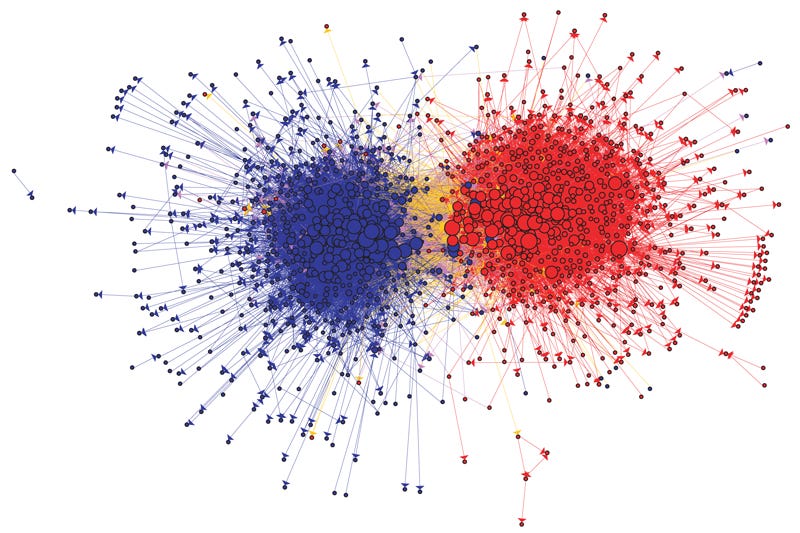How to make money on Substack: the crisis of profile polarization.
What I've observed about making money on Substack and why it drives me nuts... 🤪
P.S. Scroll to the bottom of today’s post for our first Community Wins announcement! ✨ Be sure to share your wins in the Chat to be featured in next week’s newsletter.
I’m convinced there are two polarizing profiles of money-making Substack users. Now, I’m a very black-and-white person, meaning I tend to put things in boxes that aren’t always there - but I really see these two steel ones when it comes to growing a paid subscriber list on Substack.

Before we dive in, I will point out the obvious caveat: the profiles I’m about to describe are overarching, or general. I’m not claiming that every publication making money on Substack is exactly the same; I’m saying that all the pubs I’ve come across with very high paid subscriber counts fit the general characteristics of one of these two profiles.
(However, if you can think of a completely different category, please share it in the comments! I’d love to hear your thoughts.)
Profile #1: The marketing/sales expert 🧑💼
This is the person who writes about how to grow your Substack, market your work, or launch a successful book. They post quick tips, step-by-step guides, or job boards. Their notes are typically pretty general, often in list form or pointing out notable statistics.
This person has figured out sales. They know how to convert free readers into paid ones, how to drive traffic to their newsletter, and how to craft an irresistible offer.
All this isn’t to say this is a “bad” profile. It’s just a very common personality type on Substack, which makes sense - it’s one of the most effective ways to bring in paid readers. These are the people who’ve figured out more than just writing, and they’ll both teach and use their techniques on you at the same time.
Profile #2: The authentic artist 🧑🎨
This is the person who just writes... A lot. They’re so good at the craft of writing that when their post or note gets in front of the right eyeballs, they take off. They were likely discovered by a stroke of luck, but then their writing spoke for itself. Often, these writers draft fiction novels, short stories, or academic - typically philosophical or historical - content.
This is the type of Substacker the average Joe hopes to become when they first create their profile. They hope they’ll share their serialized novel and hit the Substack lottery. There’s nothing wrong with this profile either, but it isn’t always realistic. While there are always exceptions, the incredible writers who succeed from sheer skill alone sometimes spend months or years sharing their work before it really takes off.
If there’s nothing wrong with these profiles, why does this divide “drive me crazy”?
You may be wondering why I said this trend “drives me crazy,” especially after I explained that I don’t hate either of these profiles.
The issue is, the dichotomy forces people into one camp or the other, squashing writers’ creativity and artistic growth.
Picture this: Let’s say you launch a Substack to share your evocative short stories. You don’t know anything about sales, but you heard that Substack lets you share your writing with the world and gives you a platform to reach potential readers that you wouldn’t know how to reach otherwise.
You make the layout pretty, add a logo, publish articles consistently, and post a few Notes each week that are authentic to you. But after three months, you’re barely growing. You start to wonder if you’re doing something wrong.
Six months in, you’re still stuck. Now you think you must be doing something wrong.
Meanwhile, you keep seeing marketers bragging about hitting 1,000 paid subs in half a year. You cave and subscribe to one. You quickly figure out you can’t see the advice you really need unless you upgrade to paid. You debate with yourself for a couple days, then go ahead and upgrade. You need to make the investment so you can grow your own page, right?
Before long, though, your unique voice is buried under generic content. Your posts get more structured, more templated, more… like the marketer’s. Maybe you even pivot entirely - ditching fiction for “how-to” posts - because that’s what seems to “work.”
Or maybe you’re one of the lucky artists who makes it big with your authentic writing. This isn’t just a pipe dream - it certainly does happen.
But not for everyone who wants it to. Even if you work hard, you can still miss the marketing mark that you have to hit to get your work in front of enough readers.
Alternatively, let’s say you want to write some kind of “how to” newsletter. Now you’re stuck competing with tons of people who are now looking to make as much money as possible on Substack, rather than solely those who are truly passionate about their how-to, marketing, or sales writing.
My biggest concern with this Substack divide is that it prevents creatives from being creative; that is, it causes writers to forget that the main point of writing is to write. It doesn’t have to be about making money. It can be about being creative, having fun, and improving at the craft of writing. Those goals get lost in the sea of monotony, and I fear Substack will lose its more flavorful, spunky artists to discouragement.
But why does this happen in the first place? 🤔
Polarization rises over time. A notable case study of this is the Republican-Democrat divide in modern American politics.
The above image is a representation of modern political polarization and the problem of echo chambers. Over time, we pull further from those who disagree with us and draw closer to those who agree. This may not seem problematic; I mean, of course we want to surround ourselves with people who have similar values as us, right?
But as we draw further from those with whom we disagree, we lose our ability to understand the perspectives of our opponents. The middle ground shrinks so we become unable to compromise with the other side, causing gridlock that prevents us from getting things done.
Perhaps the biggest issue with this polarization is that it causes us to subject ourselves to echo chambers, meaning we repeatedly hear the same opinions and don’t hear alternative ideas or points of view. This is likely made worse by social media and Internet algorithms, which are designed to send you more of what you agree with.
We tend to seek out things that we already agree with or that support what we believe - a concept called confirmation bias. Social media algorithms play into this tendency by feeding us content it knows we’ll like because we already agree with it.
And guess what type of person is likely receiving the same suggestions on their feed?
That’s right - people like you. So, it’s very hard to escape online echo chambers. Your feed, your comment sections, your suggestions - they likely lean in support of your opinions.
But what does rising polarization mean for Substack users?
For one thing, it means users will receive Notes and post suggestions that support their interests and beliefs. But, perhaps more importantly, it creates echo chambers among marketing experts and creative writers.
Marketing experts end up sharing very similar Notes, article topics, and “tips.” The lucky creatives (by which I mean those who have found financial success on Substack) end up writing in similar genres and sharing generic Notes.
Now, before you get out your pitchfork and hunt me down, remember that I’m admittedly overgeneralizing: all money-making writers on Substack can’t be lumped into one of two groups…
But many can.
I’d love to hear your thoughts on this: Have you noticed this polarization on Substack? Or do you see any other major Substack profile types that I’ve missed?
And how do you stay creative and encouraged as this divide grows?
✨ Community Wins ✨
- got his second annual paid subscriber, who he kindly wrote a public thank you to this week.
- recently launched his fire lifestyle brand, PAGODA. He shared the epic tale of how his brand came to be in a post last week.
Congrats to Tom and Adam on your writing wins this week! ✨ Be sure to share your wins in the Chat to be featured in next week’s newsletter:








I see the same two groups.
Then I see the group you and I and so many of our friends are in: We achieve some success (my Tranith Argan fantasy serial has almost 500 subscribers, putting me #2 when you search for “fantasy”), but not the big-time success of the famous authors who get thousands of subs quickly. We are happy with our success (I never thought I’d get this many subs), we keep contributing, we are happy to meet each other.
It’s like the business world: a few people are the CEOs and billionaire startup founders. The rest of us are like the people who get a steady paycheck and take two vacations a year and enjoy life.
Yes, this is so true! I remember when first joined Substack I didn’t know what to write ended up writing on content creation. Then the post slowly merged to how to write on Substack. I had double the subscribers I have now but every time I went to write I realized I didn’t love my niche
I decided to shift to poetry and start from scratch. It’s much more fulfilling but the growth way slower